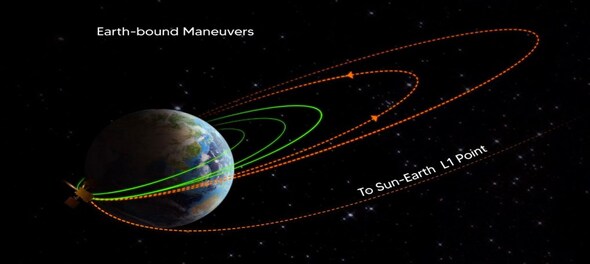
India's maiden Sun exploration mission, the Aditya L1 spacecraft, successfully completed its third earth-bound manoeuvre in the early hours of Sunday, September 10, ISRO said.
The Indian Space Research Organisation (ISRO) also announced that the next manoeuvre is scheduled for September 15, 2023, at around 2 a.m. The spacecraft is set to undergo one more earth-bound orbital manoeuvre before embarking on its transfer orbit towards Lagrange point L1.
The newly attained orbit measures 296 km x 71,767 km. The Telemetry, Tracking, and Command Network (ISTRAC) of the space agency executed this operation.
"The third Earth-bound maneuvre (EBN#3) is performed successfully from ISTRAC, Bengaluru. ISRO's ground stations at Mauritius, Bengaluru, SDSC-SHAR and Port Blair tracked the satellite during this operation. The new orbit attained is 296 km x 71767 km. The next maneuvre (EBN#4) is scheduled for September 15, 2023, around 02:00 Hrs. IST," ISRO tweeted.
Aditya-L1 Mission:The third Earth-bound maneuvre (EBN#3) is performed successfully from ISTRAC, Bengaluru.ISRO's ground stations at Mauritius, Bengaluru, SDSC-SHAR and Port Blair tracked the satellite during this operation.The new orbit attained is 296 km x 71767 km.… pic.twitter.com/r9a8xwQ4My
— ISRO (@isro) September 9, 2023
Aditya-L1 stands as India's inaugural space-based observatory, designed to explore the Sun from a halo orbit positioned at the first Sun-Earth Lagrangian point (L1), situated approximately 1.5 million km from Earth.
The second earth-bound manoeuvre was successfully completed on September 5 and the first on September 3.
These manoeuvres are deemed essential during the spacecraft's 16-day circumnavigation around Earth, enabling it to amass the necessary velocity for its onward journey to L1.
On September 2, ISRO's Polar Satellite Launch Vehicle (PSLV-C57) successfully launched Aditya-L1 from the Second Launch Pad of Satish Dhawan Space Centre, Sriharikota.
The spacecraft is projected to reach its designated orbit at point L1 roughly 127 days post-launch, according to the space agency.
ISRO asserts that a spacecraft positioned in a halo orbit around point L1 enjoys the advantage of uninterrupted Sun observation, devoid of any occultations or eclipses. This offers a significant advantage in real-time monitoring of solar activities and their influence on space weather.
Aditya-L1 carries seven homegrown scientific payloads, developed by ISRO and national research laboratories, including the Indian Institute of Astrophysics, Bengaluru, and the Inter-University Centre for Astronomy and Astrophysics, Pune.
These payloads will investigate the photosphere, chromosphere, and the outermost solar layer, the corona, employing electromagnetic, particle, and magnetic field detectors.
Out of these, four payloads will directly observe the Sun, while the remaining three will conduct in-situ studies of particles and fields at Lagrange point L1, delivering critical data concerning the propagation of solar dynamics in the interplanetary medium.
The findings from the Aditya L1 payloads are anticipated to provide invaluable insights into the enigmas surrounding coronal heating, coronal mass ejection, pre-flare and flare activities, space weather dynamics, and the behaviour of particles and fields.
In the view of scientists, there are five Lagrangian points, or gravitational parking areas, that exist between Earth and the Sun, where small objects can remain with minimal fuel consumption.
Named after Italian-French mathematician Joseph-Louis Lagrange, these points in space serve as advantageous locations for spacecraft to maintain their positions, as the gravitational forces of the Sun and Earth balance the necessary centripetal force for objects to move harmoniously with them.
With agency inputs.
Check out our in-depth Market Coverage, Business News & get real-time Stock Market Updates on CNBC-TV18. Also, Watch our channels CNBC-TV18, CNBC Awaaz and CNBC Bajar Live on-the-go!


Supreme Court says it may consider interim bail for Arvind Kejriwal due to ongoing Lok Sabha polls
May 3, 2024 4:57 PM
10% discount on fare on Mumbai Metro lines 2 and 7A on May 20
May 3, 2024 2:40 PM

